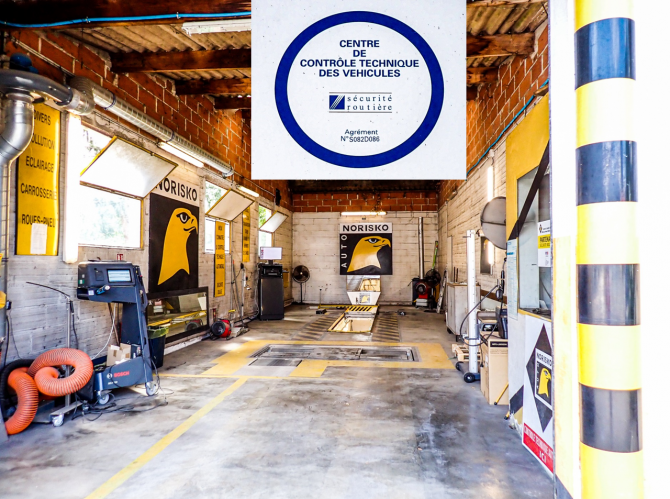Controle Techniques in France: What Car Owners Need to Know
Essential Reading


If you live in France and own a road vehicle, it will need to undergo a regular Contrôle Technique (Technical Control). Although the thought of navigating the mire of French government rules might sound daunting, the process is actually fairly straightforward. Here are the steps to guide you through every stage, along with some handy links containing further information.
What is the Contrôle Technique?
The Contrôle Technique is an inspection undertaken by a qualified mechanic at a government-approved centre. The aim is to check that your vehicle is in good mechanical working order. The objective being to ensure that it does not present a risk for you and other road users.
The inspection is similar to the annual MOT (Ministry of Transport) test in the UK and the Vehicle Safety Inspection required by some states in North America.
Here in France, the contrôle technique concerns all private vehicles. These are defined in the following way:
A motor vehicle built and designed for the transport of people, having at least four wheels, comprising, in addition to the driver’s seat, a maximum of eight seats, and whose permissible gross vehicle weight is less than 3.5 tonnes.
The first contrôle technique needs to be done several weeks before the fourth anniversary of the first registration of your vehicle. After that, is it compulsory every two years.
Contrôle techniques must be carried out by dedicated contrôle technique centres. These centres are forbidden by law from making repairs – consequently, they cannot benefit from a negative outcome.
You can find the latest on Controle Technique requirements on the French Government website.
How to Locate a Contrôle Technique Centre
Government-approved contrôle technique centres are often, though not always, on the same compound as general garages. They will display a sign identifying them as an authorised centre. If you are unsure about finding one in your area, have a look the UTAC website. It allows you to enter your area code and should provide a list of centres nearby.
Prices for the inspection vary, and each centre must display its charges in a prominent position. With that in mind, it often pays to shop around. This link will give you some idea of the current prices.
How to Book an Appointment for a Contrôle Technique
It is up to you to book the appointment. This is usually done on the phone, or by visiting the centre. When making your booking, it’s best to leave ample time before the two-year deadline in case a technical problem is found during the examination.
Once your vehicle has been through its first inspection, the centre will sometimes send out a reminder before the next appointment is due, but not always. Booking the appointment is always your responsibility.
Preparing for the Contrôle Technique
Giving your vehicle a thorough check before the contrôle technique is not a legal requirement, but it can be a valuable time and money saver. If you are not confident to do this yourself, that’s no problem.
Many garages and dealerships undertake a pre-inspection and will either offer the service free or charge a nominal fee of around 20 euros. The idea of the pre-inspection is for the garage to point out any issues, and if you wish, carry out repairs before the contrôle technique.
You will be charged for the repairs, so having an estimate before giving the go-ahead may be helpful. If necessary, you can compare prices with a different garage.
What documents are needed for the Contrôle Technique?
On the day of the contrôle technique, you must bring your carte grise (grey card), which is the Certificatd’immatriculation (official vehicle registration document). Whilst it is almost impossible to have your car pass the control without it, there are limited exceptions. You will need supporting documents to prove each circumstance:
- Your vehicle is stopped and/or impounded
- Your grey card is lost or stolen
- Your vehicle is being re-registered
The inspection takes around 45 minutes, just enough time to have a relaxing/tense coffee nearby.
What is Checked During the Contrôle Technique?
The controller has 133 checkpoints which involve the following functions:
- Vehicle identification, e.g. vehicle documents, number plate
- Braking system performance and physical condition of pads, discs, hydraulic lines
- Steering system, e.g. geometry, stability, free play
- Visibility, e.g. windscreen, mirrors
- Lights, reflectors, direction indicators
- Axles, wheels, tyres, suspension
- Chassis/body damage, corrosion
- Auxiliaries, e.g. seat belts, horn (audible warning)
- Emissions, e.g. pollution, noise level
You can find more details on each of the 133 checkpoints here.
Once the contrôle technique is complete, the inspector will tell you if your vehicle has passed the test and, if not, the action that needs to be taken. You will also be given a report which lists all defects by severity as follows:
Minor Failure: At the time of inspection has a negligible impact on vehicle safety or the environment but needs monitoring and probably rectifying before the subsequent CT. Examples of this could be brake pad or tyre wear.
Major Failure: That could endanger the safety of the vehicle and its occupants, adversely affect the environment or endanger other road users
Critical Failure: The defect poses a direct and immediate threat to road safety or has a serious impact on the environment
In addition, the report includes:
- Nature of the check (periodic technical inspection, check-up)
- Inspection date
- Result (favourable, fail due to major failure, fail due to critical failure)
- Limit of validity of the control
- Nature of the next check
- Identification of the control centre and controller
- Vehicle identification
- Kilometrage reading
- Fault results and severity levels
- All numeric test results, e.g. braking force recorded by each wheel
Following the test, the inspector will fix a small coded stamp (with the code A, S or R) to the vehicle carte griseregistration document. This gives the result of the inspection and its period of validity:
Letter A: favourable result
Letter S: unfavourable result for major failures
Letter R: unfavourable result for critical failures
The inspector will also place a coded CT (Contrôle Technique) label on the inside of the windscreen, which confirms the test validity and the next test due date.
What Happens if the Vehicle Registers a Failure at the Contrôle Technique?
It depends on the level of failure. If a minor failure is registered, the inspector will inform you and tell you to fix the problem before the next contrôle technique. The vehicle will be passed.
In the event of a major or critical failure, the vehicle will not pass its contrôle technique. Instead, a new control, called a counter-visit, must be done after making the necessary repairs or adjustments.
The date of the counter-visit will depend on the defects found during the technical check. It is likely to range from 24 hours following the control (if more than one critical failure is found) up to two months. This will be explained to you at the end of the contrôle technique.
It’s worth noting that if you take longer than the two-month time limit to get the vehicle fixed, a full re-test will need to be taken (and paid for!).
As mentioned earlier, repairs cannot be made by the contrôle technique centre. It is up to you to find a garage that can undertake the work. Once done, the counter-visit can go ahead and can be carried out by any approved contrôle techniquecentre in France. The centre will test for that specific problem only. This counter-visit is usually low cost or free.
What Are the Consequences of Ignoring the Contrôle Technique?
It’s worth remembering that the gendarmerie can easily establish whether or not the vehicle is roadworthy by checking the coded CT label inside the windscreen.
Ignoring the contrôle technique or neglecting to have repairs done after a failure can be costly. Either act constitutes a violation of the Highway Code and, as a rule, is punishable by a fixed fine of 135 euros. In certain circumstances, a fine can be reduced or increased to 750 euros.
The gendarmerie can also issue a detention order, which will result in your carte grise being temporarily retained. Seven days is given to have any repair work done. Once complete, you’ll need to attend the police station with documentary proof to reclaim your carte grise.
On the whole, sticking to the rules is less hassle!
[The author’s information supplied in this article is given in good faith based on their experience and the supplementary website material gathered during the research process.]
Driving in France
Whether you own a car in France, travel to France in your UK or EU-registered car, or hire a rental car – FrenchEntrée has all the need-to-know info about driving in France. Our Essential Reading articles will take you through buying, registering, and insuring your car, as well as offering tips and advice on driving and car ownership in France.
Share to: Facebook Twitter LinkedIn Email



